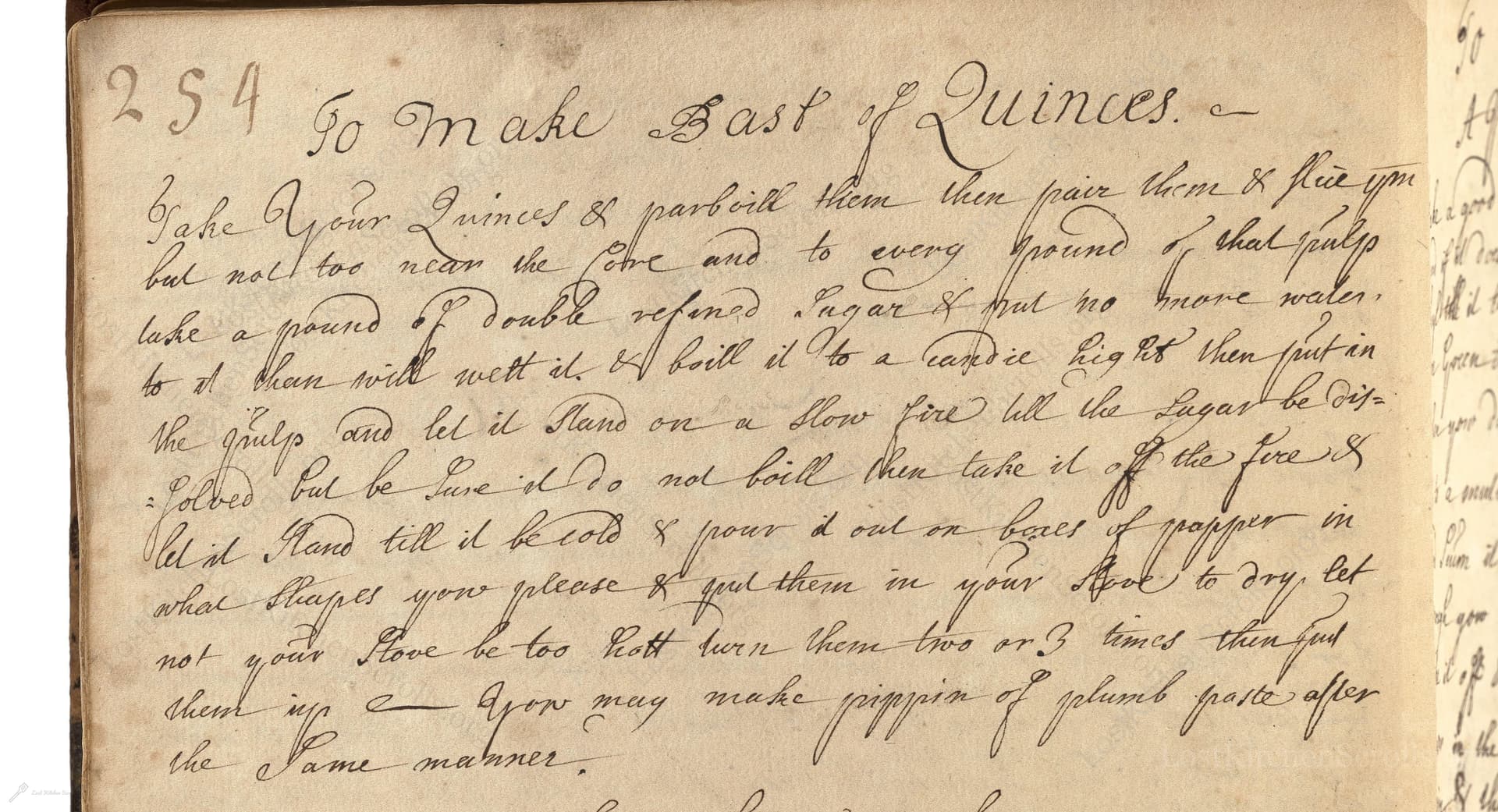To Make Past Of Quinces
From the treasured pages of Cookbook
Unknown Author

To Make Past Of Quinces
"Take Your Quinces & parboill them then pair them & slice ym but not too near the Core and to every pound of that pulp take a pound of double refined Sugar & put no more water to it than will wett it & boill it to a candie high't then put in the pulp and let it Stand on a Slow fire till all the Sugar be dissolved but be Sure it Do not boill then take it off the fire & let it Stand till it be cold & pour it out on boxes of papper in what Shapes you please & put them in your Stove to dry, let not your Stove be too hott turn them two or 3 times then put them up you may make pippin & plumb paste after the Same manner."
Note on the Original Text
Recipes from this period are written in a narrative, almost conversational style, often omitting precise measurements and cooking times. Ingredients are specified by proportion rather than absolute amounts ('to every pound of that pulp take a pound of...'), while instructions rely on the cook's judgment and experience ('put no more water to it than will wett it'). Spelling reflects early-modern English conventions—'parboill,' 'pair' (for 'pare'), and 'ym' (for 'them'). The result is a recipe that encourages adaptation and knowledge, expecting the cook to understand sugar stages, fruit preparation, and sensory cues like consistency and temperature.

Title
Cookbook (1706)
You can also click the book image above to peruse the original tome
Writer
Unknown
Era
1706
Publisher
Unknown
Background
Step back to the early 18th century with this charming culinary collection, brimming with period recipes that tantalize the tastebuds and offer a delicious glimpse into historic kitchens.
Kindly made available by
Folger Shakespeare Library
This recipe hails from early 18th-century England, around 1706, as indicated by its appearance in manuscript W.a.111. In this period, preserving fruit was both a necessity and a luxury, showing off refined sugar and culinary skill. Quince paste, or 'paste of quinces,' was served as a delicacy alongside cheese or on sweet platters, and similar pastes were made from apples (pippins) and plums. Such recipes were common amongst the gentry, who had access to sugar and dedicated drying ovens or stoves.

The historic cook would have used a large brass or copper preserving pan, a wooden spoon for stirring, a sharp paring knife for peeling and slicing, and small wooden or pasteboard boxes lined with fine paper to mold the paste. A gentle open fire or a low, controlled stone oven ('stove') provided the heat for both cooking and drying—the latter necessary for achieving the final firm texture. Modern cooks can substitute a heavy-bottomed saucepan, silicone spatula, and baking parchment, and use a domestic oven set to the lowest temperature.
Prep Time
30 mins
Cook Time
1 hr
Servings
20
We've done our best to adapt this historical recipe for modern kitchens, but some details may still need refinement. We warmly welcome feedback from fellow cooks and culinary historians — your insights support the entire community!
Ingredients
- 1 lb quince pulp (from about 1.5 lbs quinces, peeled and cored)
- 1 lb caster (superfine) sugar
- 1/2–2/3 cup water (for parboiling)
- 2–3 tablespoons water (for dissolving sugar)
- Baking paper (for lining, substitute for 'boxes of papper')
Instructions
- Begin by peeling and slicing quinces, removing the tough core but leaving as much fruit as possible.
- For every 1 lb of quince pulp, use 1 lb of caster sugar.
- Parboil the quince slices in just enough water to wet them—about 1/2 cup to 2/3 cup is sufficient.
- Once softened, mash or purée the quinces.
- In a pot, cook the sugar and a splash of water (about 2-3 tablespoons) to a thick syrup, aiming for a soft-ball or almost firm ball stage (around 240-248°F), recognizable by its thick, molten texture.
- Do not add excess water or the paste won't set.
- Stir in the quince pulp, mix over very low heat so that the sugar dissolves into the fruit completely, but do not let it boil.
- Remove from the heat and allow to cool slightly.
- Pour or spoon the paste into small boxes lined with baking paper, shaping as desired.
- Dry in a warm, dry place (like an oven on low or a dehydrator) until firm, turning occasionally.
- This sets into a jewel-red fruit paste, known today as quince cheese (membrillo).
Estimated Calories
70 per serving
Cooking Estimates
Preparing the quinces, making the syrup, and combining them takes about 30 minutes. Cooking the mixture until it thickens and dries usually takes another 1 hour. One batch yields about 20 slices, each with roughly 70 calories.
As noted above, we have made our best effort to translate and adapt this historical recipe for modern kitchens, taking into account ingredients nowadays, cooking techniques, measurements, and so on. However, historical recipes often contain assumptions that require interpretation.
We'd love for anyone to help improve these adaptations. Community contributions are highly welcome. If you have suggestions, corrections, or cooking tips based on your experience with this recipe, please share them below.
Join the Discussion
Rate This Recipe
Dietary Preference
Main Ingredients

Den Bockfisch In Einer Fleisch Suppen Zu Kochen
This recipe hails from a German manuscript cookbook compiled in 1696, a time whe...

Die Grieß Nudlen Zumachen
This recipe comes from a rather mysterious manuscript cookbook, penned anonymous...

Ein Boudain
This recipe comes from an anonymous German-language manuscript cookbook from 169...

Ein Gesaltzen Citroni
This recipe, dating from 1696, comes from an extensive anonymous German cookbook...
Browse our complete collection of time-honored recipes



